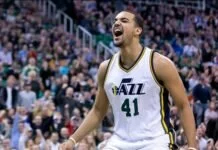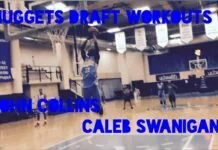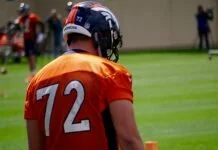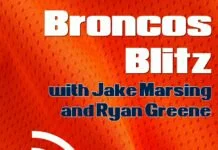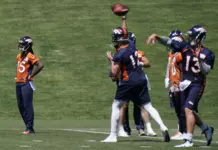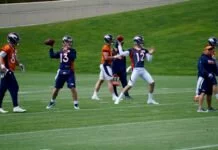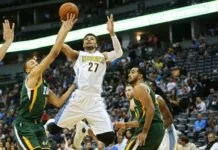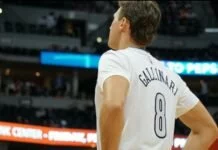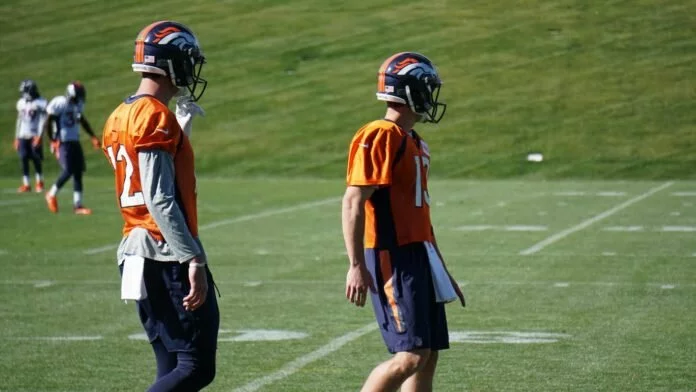Ultimately, this comes down to one question: Will Denver’s young quarterbacks ever join the ranks of the NFL’s elite? To answer that question, their performance thus far ought to be analyzed in comparison to the trends of the established quarterbacks who were not drafted in the top 10, but who were still highly successful.
This analysis, part two of a three-part series, will delve into how each quarterback got onto the field. Part three will be more systematic and examine factors such as if the quarterback was paired with a good defense, how the quarterback performed on the Wonderlic, and if the quarterback had a Pro Bowl TE to throw to.
Below is the list of the top 10 quarterbacks (as defined by career AV), who were taken outside of the top 10.
Tom Brady – 1 year as a backup before starting
Drafted in the sixth round in 2000 to be Drew Bledsoe’s backup, Brady was given the starting job when, Bledsoe, a former #1 draft pick, went down. Bledsoe had signed a record setting, ten year, $103 million contract before 2001. While Bledsoe and the New England Patriots had seen some success in prior years, their mediocre 1999 and 2000 seasons made it easier to stick with Brady when Bledsoe was cleared to play later in the season.
Drew Brees – 1 year as a backup before starting
Drew Brees was drafted by the San Diego Chargers with the first pick of the second round, but ended up sitting behind 39-year-old Doug Flutie for a year. Brees then beat out Flutie for the starting role, but struggled the next two years.
In 2004, the Chargers had the number one draft pick and ended up with Phillip Rivers. After Rivers held out of training camp, Brees landed the starting role for 2004 and made the Pro Bowl that year.
Brees was injured in the final game of the 2005 season, and was not resigned by San Diego as he had serious health questions. He ended up with the New Orleans Saints where he made a full recovery and quickly became an elite quarterback.
Aaron Rodgers- 3 seasons as a backup before starting
Aaron Rodgers was drafted in 2005 by the Green Bay Packers. After Rodgers’s rookie year, Head Coach Mike Sherman was fired and replaced with Mike McCarthy. Rodgers only played sparingly before Brett Favre’s first of many retirements.
When Favre decided he wanted to come back to Green Bay, the Packer’s re-affirmed their commitment to Rodgers, and traded Favre. Rodgers played well during his first year, posting a quarterback rating of 93.8, but the Packers still struggled and went 6-10. The team has not missed the playoffs since.
Ben Roethlisberger – started most of rookie year
Ben Roethlisberger was drafted 11th overall by the Pittsburgh Steelers. Their original plan was to have Roethlisberger ride the bench for a few years behind Charlie Batch and average incumbent Tommy Maddox, however injuries to both Batch and Maddox put Roethlisberger on the field. He went 13-0 as a starter and posted one of the all-time best rookie seasons. The following season, Roethlisberger and the Steelers won the Super Bowl.
Tony Romo – three and a half seasons as a backup before starting
Tony Romo went undrafted in 2003, but both the Denver Broncos and Dallas Cowboys were interested in bringing him in as an undrafted free agent. Romo remained a backup in Dallas for three and a half years, often buried on the depth chart.
Romo showed improvement each preseason and entered 2006 as the primary backup. Starter Drew Bledsoe was benched halfway through the season for Romo, who would go on to make the Pro Bowl for the 2006 and 2007 seasons. Romo and the Cowboys would also make the playoffs in both seasons, although they lost their first playoff game each time.
Jay Cutler – Half a season as a backup before starting
After Jake Plummer and the Denver Broncos lost the 2005 AFC Championship game, the Broncos traded up to draft Jay Cutler 11th overall. Offensive Coordinator Gary Kubiak left to go to the Houston Texans and, without him, Plummer put up one of his worst seasons.
Plummer was benched for Cutler. Cutler finished the season 2-3 and the Broncos missed the playoffs. Cutler played well the next two years, before clashing with Josh McDaniels, and being shipped off to the Chicago Bears. Cutler had many ups and downs, but ultimately only made the playoffs once, and never made a Pro Bowl in Chicago.
Joe Flacco – Started all of his rookie season
After their 5-11 2007 season, the Baltimore Ravens traded down, then up to grab Joe Flacco at 18th overall. The Raven’s other quarterbacks at the time were Kyle Boller, a late first round pick who had played very poorly during his first 5 seasons and Troy Smith, the former Heisman Trophy winner who was unable to adjust to the NFL.
Kyle Boller initially won the starting job, but he was placed on injured reserve. With Troy Smith also battling infected tonsils, Flacco was named the starter and would go on to start every game for the Ravens for the next 7 years. His play was not stellar and he has never gone to a Pro Bowl, but it was a big improvement for the Ravens and the team was successful.
Russel Wilson – Started all of his rookie season
Russel Wilson was drafted in the third round by the Seattle Seahawks. He was the 6th quarterback chosen in what turned out to be a very deep and successful quarterback draft class. The Seahawks had just traded for Matt Flynn, who was hot off his 6 TD, 480 yard meaningless season finale with Green Bay. Also on the roster was Tavares Jackson, who had played unexceptionally for the Seahawks the year before. Wilson won the starting job in preseason and never looked back. He started every game for Seattle and earned Pro Bowl honors in his first and second year.
Matt Schaub – three seasons as a backup before starting
After Michael Vick missed most of 2003 with a broken leg, the Atlanta Falcons drafted Matt Schaub in the third round in 2004. Due to Vick’s style of play, Schaub saw frequent yet sporadic action. His relief performances combined with a few qualities starts and strong preseason performances, lead to his trade to the Houston Texans for two second round draft picks.
Schaub replaced David Carr in Houston and initially struggled with injuries and inconsistent play, but earned Pro Bowl honors in his third season as a starter. Schaub put up good numbers for several years, before his injuries and poor play cost him his starting job in 2013.
Andy Dalton – Started all of his rookie season
Dalton was drafted 35th overall in the 2011 draft, the fifth quarterback taken that year, and one pick before Colin Kaepernick. The Cincinnati Bengals were coming off a 4-12 season and incumbent Carson Palmer demanded a trade and refused to play again for the Bengals. Palmer would later be traded midseason to the Raiders.
With Palmer out of the picture, Bruce Grodkowski was the only competition on the roster for Dalton. Dalton won the starting job in preseason, and would go on to start every game for the Bengals for the next 4+ years. Dalton was named to the Pro Bowl his rookie season and was runner-up to Cam Newton for Rookie of the Year. Dalton led the Bengals to 5 straight playoff appearances, although they always went ‘one and done’.
Trends with getting on the field
Of the ten quarterbacks examined, five were starters by the end of their rookie years, two spent one year learning the ropes, and three spent a full three years as backups. Only three of ten seized a starting role due to another’s injury and only four of ten started midseason.
Siemian had one season on the bench before his first season as starter and Lynch has already had at least one. With reports coming out that Siemian’s injury was more serious than first reported, it appears Lynch may have missed his opportunity to seize the starting role after Siemian was hurt.
Coaching changes
Six of ten quarterbacks saw coaching changes early on in their career. Brees and Rodgers saw coaching changes after year 1, Roethlisberger saw a change after he won the Super Bowl in year 2, Schaub and Cutler both changed teams after their third year, and Romo saw a head coaching change after his fourth year.
Roethlisberger, and Cutler both had big down years after their coaching changes. Schaub didn’t hit the ground running in Houston like they had hoped. The coaching switch was probably good for Rodgers, but he had two more years on the bench to learn the new system.
While this is encouraging for the Broncos who just underwent a coaching change and likely scheme overhaul, arguably all six of those quarterbacks saw their development slow due to a coaching change. This suggests the coaching change may not be a death blow to Siemian or Lynch, but may slow their progress.
Quarterback battles
Only four of ten won legitimate preseason quarterback competitions by injury or by level of play. Andy Dalton beat out Bruce Gradkowski, Joe Flacco beat out the injured Kyle Boller, Drew Brees beat out 40-year-old Doug Fluttie, and Russel Wilson beat out Tavares Jackson and Matt Flynn. This may be hindsight bias, but in every case, it seems the deck was stacked heavily in the winning quarterback’s favor, with Wilson being the exception.
Heading into last year’s training camp, it was easy to believe that Lynch should have had the upper hand over Siemian, based solely on his draft position. However, Siemian’s extra year in the offense was an underrated advantage. Now, both quarterbacks will have to learn a new system, but Siemian has a year of NFL experience, and more chemistry with an offense that has been mostly retained.
Part one, examining the long odds drafted QBs face can be found here.



